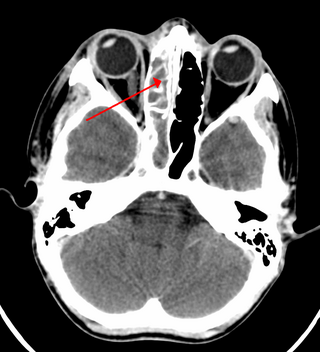
Sinusitis, also known as rhinosinusitis, is an inflammation of the mucous membranes that line the sinuses resulting in symptoms that may include thick nasal mucus, a plugged nose, and facial pain.
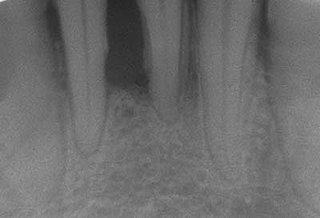
Periodontal disease, also known as gum disease, is a set of inflammatory conditions affecting the tissues surrounding the teeth. In its early stage, called gingivitis, the gums become swollen and red and may bleed. It is considered the main cause of tooth loss for adults worldwide. In its more serious form, called periodontitis, the gums can pull away from the tooth, bone can be lost, and the teeth may loosen or fall out. Halitosis may also occur.

A toothbrush is a special type of brush used to clean the teeth, gums, and tongue. It consists of a head of tightly clustered bristles, atop of which toothpaste can be applied, mounted on a handle which facilitates the cleaning of hard-to-reach areas of the mouth. They should be used in conjunction with something to clean between the teeth where the bristles of the toothbrush cannot reach - for example floss, tape or interdental brushes.

Lead poisoning, also known as plumbism and saturnism, is a type of metal poisoning caused by lead in the body. Symptoms may include abdominal pain, constipation, headaches, irritability, memory problems, infertility, and tingling in the hands and feet. It causes almost 10% of intellectual disability of otherwise unknown cause and can result in behavioral problems. Some of the effects are permanent. In severe cases, anemia, seizures, coma, or death may occur.

Teething is the process by which an infant's first teeth appear by emerging through the gums, typically arriving in pairs. The mandibular central incisors are the first primary teeth to erupt, usually between 6 and 10 months of age and usually causes discomfort and pain to the infant. It can take several years for all 20 teeth to complete the tooth eruption. Though the process of teething is sometimes referred to as "cutting teeth", when teeth emerge through the gums they do not cut through the flesh. Instead, hormones are released within the body that cause some cells in the gums to die and separate, allowing the teeth to come through.
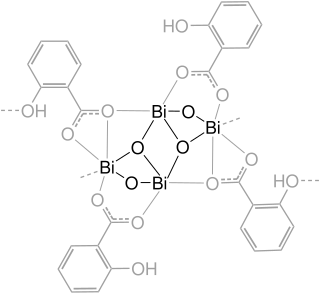
Bismuth subsalicylate, sold generically as pink bismuth and under brand names including Pepto-Bismol, Pepti-Calm and BisBacter, is a medication used to treat temporary discomfort of the stomach and gastrointestinal tract. This includes an upset stomach, heartburn or other similar symptoms.

Toothaches, also known as dental pain or tooth pain, is pain in the teeth or their supporting structures, caused by dental diseases or pain referred to the teeth by non-dental diseases. When severe it may impact sleep, eating, and other daily activities.

Erethism, also known as erethismus mercurialis, mad hatter disease, or mad hatter syndrome, is a neurological disorder which affects the whole central nervous system, as well as a symptom complex, derived from mercury poisoning. Erethism is characterized by behavioral changes such as irritability, low self-confidence, depression, apathy, shyness and timidity, and in some extreme cases with prolonged exposure to mercury vapors, by delirium, personality changes and memory loss. People with erethism often have difficulty with social interactions. Associated physical problems may include a decrease in physical strength, headaches, general pain, and tremors, as well as an irregular heartbeat.
Bismuthia is a rare dermatological condition that results from the prolonged use of bismuth.
Dentin hypersensitivity is dental pain which is sharp in character and of short duration, arising from exposed dentin surfaces in response to stimuli, typically thermal, evaporative, tactile, osmotic, chemical or electrical; and which cannot be ascribed to any other dental disease.

A dental abscess is a localized collection of pus associated with a tooth. The most common type of dental abscess is a periapical abscess, and the second most common is a periodontal abscess. In a periapical abscess, usually the origin is a bacterial infection that has accumulated in the soft, often dead, pulp of the tooth. This can be caused by tooth decay, broken teeth or extensive periodontal disease. A failed root canal treatment may also create a similar abscess.
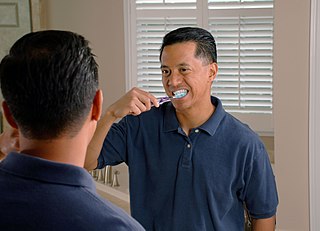
Tooth brushing is the act of scrubbing teeth with a toothbrush equipped with toothpaste. Interdental cleaning can be useful with tooth brushing, and together these two activities are the primary means of cleaning teeth, one of the main aspects of oral hygiene. The recommended amount of time for tooth brushing is two minutes each time for two times a day.
Tooth loss is a process in which one or more teeth come loose and fall out. Tooth loss is normal for deciduous teeth, when they are replaced by a person's adult teeth. Otherwise, losing teeth is undesirable and is the result of injury or disease, such as dental avulsion, tooth decay, and gum disease. The condition of being toothless or missing one or more teeth is called edentulism. Tooth loss has been shown to causally reduce overall health and wellbeing as it increases the probability of depression.

Metal toxicity or metal poisoning is the toxic effect of certain metals in certain forms and doses on life. Some metals are toxic when they form poisonous soluble compounds. Certain metals have no biological role, i.e. are not essential minerals, or are toxic when in a certain form. In the case of lead, any measurable amount may have negative health effects. There is a popular misconception that only heavy metals can be toxic, but lighter metals such as beryllium and lithium can be toxic too. Not all heavy metals are particularly toxic, and some are essential, such as iron. The definition may also include trace elements when abnormally high doses may be toxic. An option for treatment of metal poisoning may be chelation therapy, a technique involving the administration of chelation agents to remove metals from the body.
Treponema denticola is a Gram-negative, obligate anaerobic, motile and highly proteolytic spirochete bacterium. It is one of four species of oral spirochetes to be reliably cultured, the others being Treponema pectinovorum, Treponema socranskii and Treponema vincentii. T. denticola dwells in a complex and diverse microbial community within the oral cavity and is highly specialized to survive in this environment. T. denticola is associated with the incidence and severity of human periodontal disease. Treponema denticola is one of three bacteria that form the Red Complex, the other two being Porphyromonas gingivalis and Tannerella forsythia. Together they form the major virulent pathogens that cause chronic periodontitis. Having elevated T. denticola levels in the mouth is considered one of the main etiological agents of periodontitis. T. denticola is related to the syphilis-causing obligate human pathogen, Treponema pallidum subsp. pallidum. It has also been isolated from women with bacterial vaginosis.
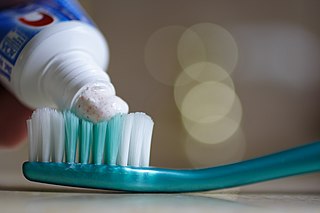
Oral hygiene is the practice of keeping one's oral cavity clean and free of disease and other problems by regular brushing of the teeth and adopting good hygiene habits. It is important that oral hygiene be carried out on a regular basis to enable prevention of dental disease and bad breath. The most common types of dental disease are tooth decay and gum diseases, including gingivitis, and periodontitis.

Bismuth is a chemical element with the symbol Bi and atomic number 83. It is a post-transition metal and one of the pnictogens, with chemical properties resembling its lighter group 15 siblings arsenic and antimony. Elemental bismuth occurs naturally, and its sulfide and oxide forms are important commercial ores. The free element is 86% as dense as lead. It is a brittle metal with a silvery-white color when freshly produced. Surface oxidation generally gives samples of the metal a somewhat rosy cast. Further oxidation under heat can give bismuth a vividly iridescent appearance due to thin-film interference. Bismuth is both the most diamagnetic element and one of the least thermally conductive metals known.

Gingivitis is a non-destructive disease that causes inflammation of the gums; ulitis is an alternative term. The most common form of gingivitis, and the most common form of periodontal disease overall, is in response to bacterial biofilms that are attached to tooth surfaces, termed plaque-induced gingivitis. Most forms of gingivitis are plaque-induced.

Henry Burton was a British physician and chemist, who identified that blue discolouration of gums, the eponymous Burton line, was a symptom of lead poisoning.

Biting is an action involving a set of teeth closing down on an object. It is a common zoological behavior, being found in toothed animals such as mammals, reptiles, amphibians, fish, and arthropods. Biting is also an action humans participate in, most commonly when chewing food. Myocytic contraction of the muscles of mastication is responsible for generating the force that initiates the preparatory jaw abduction (opening), then rapidly adducts (closes) the jaw and moves the top and bottom teeth towards each other, resulting in the forceful action of a bite. Biting is one of the main functions in the lives of larger organisms, providing them the ability to forage, hunt, eat, build, play, fight, protect, and much more. Biting may be a form of physical aggression due to predatory or territorial intentions. In animals, biting can also be a normal activity, being used for eating, scratching, carrying objects, preparing food for young, removing ectoparasites or irritating foreign objects, and social grooming. Humans can have the tendency to bite each other whether they are children or adults.
















